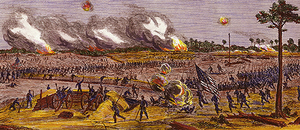Battle of Fort Blakely
| Battle of Fort Blakely | |||||||
|---|---|---|---|---|---|---|---|
| Part of the American Civil War | |||||||
 Storming of Fort Blakely |
|||||||
|
|||||||
| Belligerents | |||||||
|
|
|
||||||
| Commanders and leaders | |||||||
| Edward Canby | St. John R. Liddell | ||||||
| Units involved | |||||||
| Army of West Mississippi | Fort Blakely Garrison | ||||||
| Strength | |||||||
| 45,000 | 4,000 | ||||||
| Casualties and losses | |||||||
| 629 | 2,900 | ||||||
Coordinates: 30°44′32.67″N 87°55′37.34″W / 30.7424083°N 87.9270389°W
Union victory
The Battle of Fort Blakely took place from April 2-April 9, 1865 in Baldwin County, Alabama, as part of the Mobile Campaign of the American Civil War.
Maj. Gen. Edward Canby's Union forces, the XVI and XIII Corps, moved along the eastern shore of Mobile Bay, forcing the Confederates back into their defenses. Union forces then concentrated on Spanish Fort, Alabama and nearby Fort Blakely. By April 1, Union forces had enveloped Spanish Fort, thereby releasing more troops to focus on Fort Blakely. Confederate Brig. Gen. St. John R. Liddell, with about 4,000 men, held out against the much larger Union force until Spanish Fort fell on April 8 in the Battle of Spanish Fort. This allowed Canby to concentrate 16,000 men for the attack on April 9, led by Brig. Gen. John P. Hawkins. Sheer numbers breached the Confederate earthworks, compelling the Confederates, including Liddell, to surrender. The siege and capture of Fort Blakely was basically the last combined-force battle of the war. Yet, it is criticized by some (such as Ulysses S. Grant) as an ineffective contribution to Union war effort due to Canby's lateness in engaging his troops. The battle was actually fought hours after the Confederate General Robert E. Lee surrendered at Appomattox. The battle is considered the last major battle of the war. African-American forces played a major role in the successful Union attack. As a result of this battle, Union forces would finally be able to occupy the city of Mobile, Alabama on April 12, 1865.
...
Wikipedia
